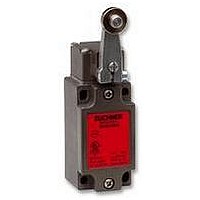NZ1HS-2131-M EUCHNER, NZ1HS-2131-M Datasheet - Page 110

NZ1HS-2131-M
Manufacturer Part Number
NZ1HS-2131-M
Description
SAFETY SWITCH
Manufacturer
EUCHNER
Datasheet
1.NZ1HS-2131-M.pdf
(127 pages)
Specifications of NZ1HS-2131-M
Actuation Type
Lever
Operating Force Max
15N
Contact Voltage Ac Max
230V
Contact Voltage Dc Max
24V
Contact Current Ac Max
4A
Contact Current Dc Max
4A
Switch Terminals
Screw
Actuator Type
Lever Arm
Actuator Style
Lever
- Current page: 110 of 127
- Download datasheet (8Mb)
Appendix
Protective plate
For switches with separate actuator, a protective plate is available as an
option; this plate makes it more difficult to tamper with the actuating
head.
Protection against unintentional closing
Protection against unintentional closing of an interlocking device with
the locked position with the safety guard open and therefore signaling
a safe state.
Redundancy
Redundancy is the use of more than one system to always maintain the
same safety function even on the failure of individual components.
Even on the use of a position switch with two positively driven normally
closed contacts, often the term redundant (dual-channel) system is used.
However, here it is to be noted that only duplication of the safety contacts
is achieved, the mechanical drive (trip dog and plunger) remains single-
channel as before. To setup a redundant system (from safety category
3 according to EN 954 1) both the mechanism (two position switches)
and the electronics should be of dual-channel layout. The safety of a
redundant system is further increased by diversity .
guard locking mechanically prevents the safety switch changing to
110
Actuator
Switch locked
and guard
locked
Protective plate on safety switch without guard locking
Symbol for a positively driven contact
11
23
24
12
11
23
solenoid
locking
Guard
24
12
Actuator
Protection
against
unintentional
closing of the
guard locking
active
11
23
24
12
11
23
solenoid
locking
Guard
24
12
Release path
A release path is used to generate a safety-related output signal. Re-
lease paths act to the exterior like normally open contacts.
Risk
The combination of the probability and the severity of injury in a hazardous
situation.
Risk assessment
The standard EN 1050 contains procedures necessary to perform a
risk assessment. The risk assessment initially involves a risk analysis
and a subsequent risk evaluation. In EN 954 1 there is a simple procedure
for determining the required category to match the risk .
Retention force
The retention force is the maximum force that is allowed to be applied
to the actuator with the safety switch in the locked state so that the
switch cannot be unlocked.
Safe state
A safe state is provided if no hazard can be produced by a system or
machine on correct use (cf. hazardous situations ).
Safety guard
A safety guard is intended to protect people, products and the
environment from hazards. A differentiation is made between movable
safety guards and fixed safety guards.
Safety relay
Safety relays are used to evaluate switchgear connected (safety switches,
emergency stop switchgear, etc.). They ensure that the OSSD (Output
Signal Switching Device) is opened.
Safety switch
A safety switch is part of a safety chain. It provides a safe signal in the
input circuit. A stop signal is generated when the safety guard is opened.
In this way unintentional machine starting is prevented when the safety
guard is open, that is interlocking is achieved.
Movable safety guard with redundant safety switches
Safety relay ESM
Related parts for NZ1HS-2131-M
Image
Part Number
Description
Manufacturer
Datasheet
Request
R

Part Number:
Description:
ACTUATOR
Manufacturer:
EUCHNER
Datasheet:

Part Number:
Description:
ACTUATOR
Manufacturer:
EUCHNER
Datasheet:

Part Number:
Description:
ACTUATOR
Manufacturer:
EUCHNER
Datasheet:

Part Number:
Description:
ACTUATOR
Manufacturer:
EUCHNER
Datasheet:

Part Number:
Description:
JOYSTICK SWITCH
Manufacturer:
EUCHNER
Datasheet:

Part Number:
Description:
JOYSTICK SWITCH
Manufacturer:
EUCHNER
Datasheet:

Part Number:
Description:
JOYSTICK SWITCH
Manufacturer:
EUCHNER
Datasheet:

Part Number:
Description:
JOYSTICK SWITCH
Manufacturer:
EUCHNER
Datasheet:

Part Number:
Description:
JOYSTICK SWITCH
Manufacturer:
EUCHNER
Datasheet:

Part Number:
Description:
LIMIT SWITCH, SINGLE
Manufacturer:
EUCHNER
Datasheet:

Part Number:
Description:
SAFETY SWITCH
Manufacturer:
EUCHNER
Datasheet:

Part Number:
Description:
SAFETY SWITCH
Manufacturer:
EUCHNER
Datasheet:

Part Number:
Description:
SAFETY SWITCH
Manufacturer:
EUCHNER
Datasheet:

Part Number:
Description:
SAFETY SWITCH
Manufacturer:
EUCHNER
Datasheet:











